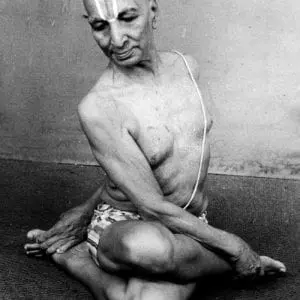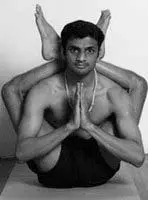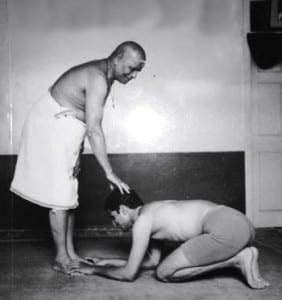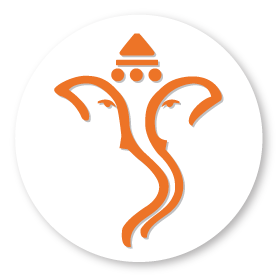ASHTANGA YOGA

Ashtanga Yoga: Ashtanga Yoga is an ancient system of Yoga that was taught by Vamana Rishi in the Yoga Korunta. This text was imparted to Sri T. Krishnamacharya in the early 1900’s by his Guru Rama Mohan
The following are aspects that Pattabhi Jois emphasizes as the main components of Ashtanga Yoga.
Vinyasa: Vinyasa means breathing and movement system. For each movement, there is one breath. For example, in Surya Namskar there are nine vinyasas. The first vinyasa is inhaling while raising your arms over your head, and putting your hands together; the second is exhaling while bending forward, placing your hands next to your feet, etc. In this way all asanas are assigned a certain number of vinyasas.
The purpose of vinyasa is for internal cleansing. Breathing and moving together while performing asanasmakes the blood hot, or as Pattabhi Jois says, boils the blood. Thick blood is dirty and causes disease in the body. The heat created from yoga cleans the blood and makes it thin, so that it may circulate freely. The combination of the asanas with movement and breath make the blood circulate freely around all the joints, taking away body pains. When there is a lack of circulation, pain occurs. The heated blood also moves through all the internal organs removing impurities and disease, which are brought out of the body by the sweat that occurs during practice.
 Sweat is an important by product of vinyasa, because it is only through sweat that disease leaves the body and purification occurs. In the same way that gold is melted in a pot to remove its impurities, by the virtue of the dirt rising to the surface as the gold boils, and the dirt then being removed, yoga boils the blood and brings all our toxins to the surface, which are removed through sweat. If the method of vinyasa is followed, the body becomes healthy and strong, and pure like gold.
Sweat is an important by product of vinyasa, because it is only through sweat that disease leaves the body and purification occurs. In the same way that gold is melted in a pot to remove its impurities, by the virtue of the dirt rising to the surface as the gold boils, and the dirt then being removed, yoga boils the blood and brings all our toxins to the surface, which are removed through sweat. If the method of vinyasa is followed, the body becomes healthy and strong, and pure like gold.
After the body is purified, it is possible to purify the nervous system, and then the sense organs. These first steps are very difficult and require many years of practice. The sense organs are always looking outside, and the body is always giving into laziness. However, through determination and diligent practice, these can be controlled. After this is accomplished, mind control comes automatically. Vinyasa creates the foundation for this to occur.
 Tristhana: This means the three places of attention or action: posture, breathing system and looking place. These three are very important for yoga
Tristhana: This means the three places of attention or action: posture, breathing system and looking place. These three are very important for yoga
Asanas purify, strengthen and give flexibility to the body. Breathing is
For cleaning the body internally two factors are necessary, air and fire. The place of fire in our bodies is four inches below the navel. This is the standing place of our life force. In order for fire to burn, air is necessary, hence the necessity of the breath. If you stoke a fire with a blower, evenness is required so that the flame is not smothered out, or blown out of control.
The same method stands for the breath. Long even breaths will strengthen our internal fire, increasing heat in the body which in turn heats the blood for physical purification, and burns away impurities in the nervous system as well. Long even breathing increases the internal fire and strengthens the nervous system in a controlled manner and at an even pace. When this fire is strengthened, our digestion, health
An important component of the breathing system is
The six poisons: A vital aspect of internal purification that Pattabhi Jois teaches relates to the six poisons that surround the spiritual heart. In the yoga shastra it is said that God dwells in our heart in the form of light, but this light is covered by six poisons: kama, krodha, moha, lobha, matsarya, and mada. These are desire, anger, delusion, greed, envy and sloth. When yoga practice is sustained with great diligence and dedication over a long period of time, the heat generated from it burns away these poisons, and the light of our inner nature shines forth.
This forms the practical and philosophic basis of Ashtanga Yoga as taught by Sri K. Pattabhi Jois.
 Parampara is knowledge that is passed in succession from teacher to student. It is a Sanskrit word that denotes the principle of transmitting knowledge in its most valuable form; knowledge based on direct and practical experience. It is the basis of any lineage: the teacher and student form the links in the chain of instruction that has been passed down for thousands of years. In order for yoga instruction to be effective, true and complete, it should come from within parampara.
Parampara is knowledge that is passed in succession from teacher to student. It is a Sanskrit word that denotes the principle of transmitting knowledge in its most valuable form; knowledge based on direct and practical experience. It is the basis of any lineage: the teacher and student form the links in the chain of instruction that has been passed down for thousands of years. In order for yoga instruction to be effective, true and complete, it should come from within parampara.
Knowledge can be transferred only after the student has spent many years with an experienced guru, a teacher to whom he has completely surrendered in body, mind, speech and inner being. Only then is he fit to receive knowledge. This transfer from teacher to student is parampara.
The dharma, or duty, of the student is to practice diligently and to strive to understand the teachings of the guru. The perfection of knowledge – and of yoga — lies beyond simply mastering the practice; knowledge grows from the mutual love and respect between student and teacher, a relationship that can only be cultivated over time.
The teacher’s dharma is to teach yoga exactly as he learned it from his guru. The teaching should be presented with a good heart, with good purpose and with noble intentions. There should be an absence of harmful motivations. The teacher should not mislead the student in any way or veer from what he has been taught.
The bonding of teacher and student is a tradition reaching back many thousands of years in India, and is the foundation of a rich, spiritual heritage. The teacher can make his students steady – he can make them firm where they waver. He is like a father or mother who corrects each step in his student’s spiritual practice.
The yoga tradition exists in many ancient lineages, but today some are trying to create new ones, renouncing or altering their guru’s teachings in favor of new ways. Surrendering to parampara, however, is like entering a river of teachings that has been flowing for thousands of years, a river that age-old masters have followed into an ocean of knowledge. Even so, not all rivers reach the ocean, so one should be mindful that the tradition he or she follows is true and selfless.
Many attempt to scale the peaks in the Himalayas, but not all succeed. Through courage and surrender, however, one can scale the peaks of knowledge by the grace of the guru, who is the holder of knowledge, and who works tirelessly for his students.
For more info please see kpjayi.org
MYSORE STYLE
Mysore style is a class named after the city where ashtanga originated from, Mysore, India. In this class you are taught individually, one on one, in a group setting. Step by step you are taught a posture (asana) and sequence (vinyasa) in detail with a particular breath pattern. The teacher guides you on your progression as you learn and retain the information taught to you. This enables you to internalise the practice, build and retain a daily yoga practice while being able to focus on yourself and move/progress at your own pace. This is the traditional way yoga is taught, with this method you can evolve physically, mentally and spiritually without distraction, confusion and doubt.
